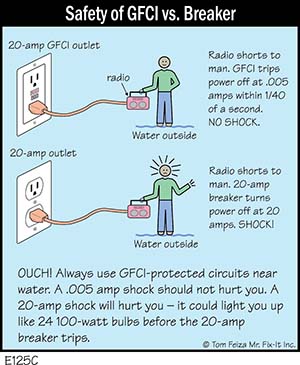Ground Fault Circuit Interrupters (GFCI) are safety devices used to protect people from shock and electrocution. There are two types of devices. One is a a receptacle, commonly called an outlet, which has a test button and reset button. The other device is a special breaker. Both will trip if they sense a reduction of electricity going in. Homeowners should understand how they work and what they need to know about them.
How they work
In order to understand a GFCI, start with understanding the basics of electricity.

- Think of the flow of electricity as a loop.
- A house gets its electricity from the utility company’s transformer installed either on top of a pole or in a box in the yard.
- Power travels from the transformer to the service entrance panel or meter outside of the house.
- From there, it travels to the service panel inside the house.
- The service panel sends power along branch circuits to outlets, light fixtures, and hardwired appliances.
- The service panel sends electricity through the “hot” (black or colored) wire to an outlet or other hardwired device. Any electricity not used returns to the service panel on the “neutral” (white) wire.
A GFCI device monitors the power going in and out of the outlet as described above. When something plugged into an outlet fails, the amount of power going back though the outlet is often reduced because it is diverted elsewhere. When the GFCI detects a reduction in returning power, it immediately shuts off outgoing power. For example, if you’re touching a hair dryer that has an electrical problem, power can travel through you to the ground instead of back into the receptacle. As the conductor of that power, you could be electrocuted. A GFCI would detect the fact that the power coming back to it is reduced, and trip.
Where to use a GFCI
Today’s current code requirements specify installation of GFCI breakers or receptacles (outlets) at kitchen countertops, dishwashers, bathrooms, outdoors, garages, decks and balconies, laundry areas, unfinished basements, and within 6 feet of faucets.
How to test the devices
Follow these steps to test a GFCI receptacle:
- Read the manufacturer’s manual for specific information regarding testing and safety precautions.
- A GFCI receptacle will have a TEST and RESET button. Press the TEST button and listen for a popping noise, this will turn the power off.
- Press the RESET button to turn power back on.
Follow these steps to test a GFCI breaker:
- Again, read the manufacturer’s manual for specific information regarding testing and safety precautions.
- A GFCI breaker will have a TEST button from which a popping noise should be heard when pressing the TEST button. The breaker’s lever will shift to the middle position and, in most cases, it will display a red indicator.
- To restore power, move the lever to the off position then flip it to the on position.
You’ll know you have a faulty GFCI device if one or more of the following things happen.
- The reset button doesn’t pop out so the power is not turned off when there’s a problem.
- The GFCI breaker’s lever doesn’t trip so the power is not turned off when there’s a problem.
- You can’t reset the devices.
If a GFCI device fails, have a qualified electrician replace it immediately.
